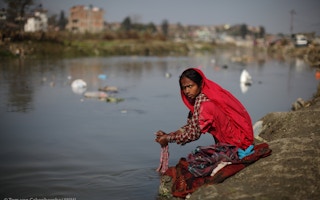As the monsoon draws to a close in Nepal, workers are putting the finishing touches on a dam designed to breathe life back into a sacred river that’s effectively dead.
The Bagmati stems from a spring in the hills about 15 kilometres ( 9.3 miles) north of Nepal’s capital, Kathmandu, and its path to the city is dotted with Hindu shrines. By the time it winds its way through Kathmandu, however, the river is essentially a black slurry of solid waste, untreated sewage and industrial effluent. A 2017 study declared the water quality “extremely poor and not suitable for aquatic life.”
But officials say they hope to turn things around with the Dhap Dam project. The 24-meter-high (79-foot) dam will hold back a reservoir that, when filled to capacity, will hold 861,000 cubic meters (227 million gallons) of water.
“We plan to complete the construction of the dam this October,” said project lead Krishna Rijal. “We have already started filling the reservoir with water from the rain this year. But we may have to wait until the next monsoon for the reservoir to be filled.”
Rainwater is the key ingredient for the Bagmati, which makes it unlike most of the other rivers in Nepal.
“
The main problem is the attitude of the people toward the river. We consider it a holy river, yet we throw solid waste and dispose of untreated sewage in the river. No amount of engineering and construction can address this issue.
Bhesh Raj Thapa, water resources engineer, Universal Engineering and Science College
“Unlike the perennial snow-fed rivers that originate in the Himalayas, the Bagmati is fed by spring water,” said water resources engineer Bhesh Raj Thapa, adding that several natural springs along the course of the river contribute to its flow.
But due to unplanned urbanisation, the paving over of large areas in the basin, and the construction of roads along the riverbank, the natural springs are drying up: rainwater runoff can’t percolate into the soil and recharge the aquifers. This means that these springs release less water into the river during the dry season.
The river swells during the monsoon rains, when Nepal receives 60-90 per cent of its annual rainfall in just four months, then diminishes to a trickle — as little as 3 per cent of its peak — during the dry season. During these eight months of the year, the only water flowing into the river comes from untreated sewage.
“We hope that the new dam will help bring back the aquatic life in the river by maintaining its flow during the dry season,” Rijal said.
The revival of the river should also be a boon to the pilgrims who visit the various temples along the river’s course during important festivals that fall in the dry season, he added. Bathing in the river is an important part of many rituals that are centred on the Bagmati, whose banks are also an important cremation site for Hindus. Rijal added the dam area can be developed as a tourism site.
The Dhap Dam is part of the government’s $36 million Bagmati River Basin Improvement Program, launched in 2014. The program aims to restore the flow of water in the river and implement an integrated water resources management approach with the participation of residents of the basin.
As part of the program, officials aim to revitalise the springs that feed the Bagmati, reduce pollution with a new sewage treatment plant, harvest rainwater, beautify riverside areas in the city, and implement an early flood warning system.
Critics, and even officials, say that while all these efforts are likely to improve the condition of the river, they won’t be enough to revive it.
“There are many issues that need to be dealt with,” Rijal said. “For example, there are a lot of diversions in the river in its headwaters. Water is diverted for irrigation as well as for drinking water.”
The river’s main portion in Kathmandu, where it’s the most polluted, may not get a lot of water in the dry season, he added. “Also, when there is more water available upstream during the dry season, the people there might increase the volume of water they withdraw from the river,” he said.
Thapa, the water resources engineer, said the technical efforts to save the river still need to be appreciated as they provide hope for a river that has nurtured the people of the Kathmandu Valley for centuries.
“But I think the main problem is the attitude of the people toward the river,” he said. “We consider it a holy river, yet we throw solid waste and dispose of untreated sewage [in the river]. No amount of engineering and construction can address this issue.”
The Department of Irrigation has commissioned an environmental impact assessment of a second dam in the headwaters of the Bagmati, the Nagmati dam, with an eye to making more water available for the river during the dry season. But how much of it will reach downstream and remain unpolluted remains uncertain.
This story was published with permission from Mongabay.com.

















